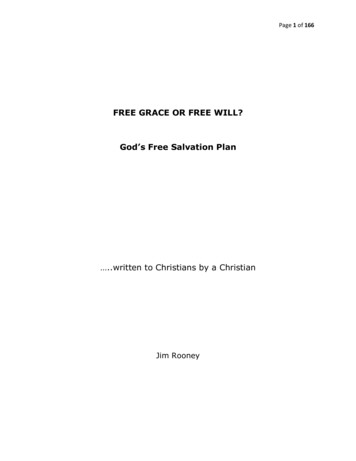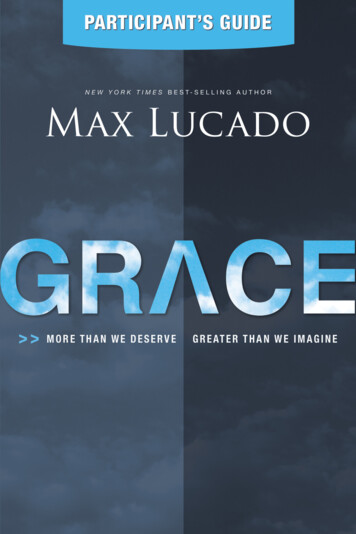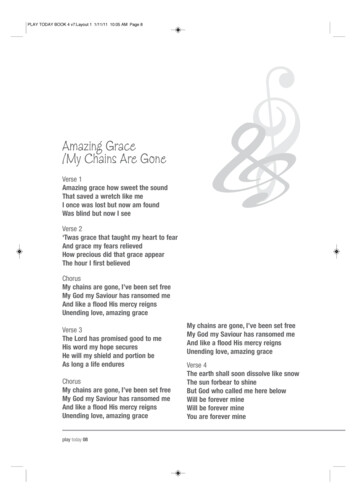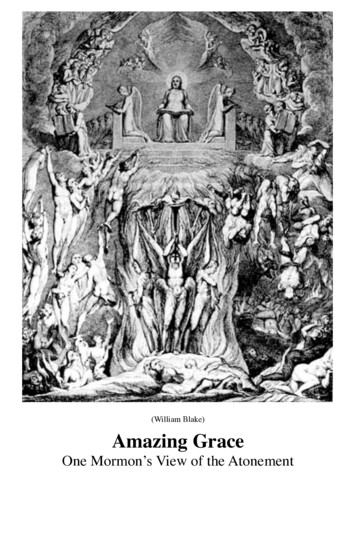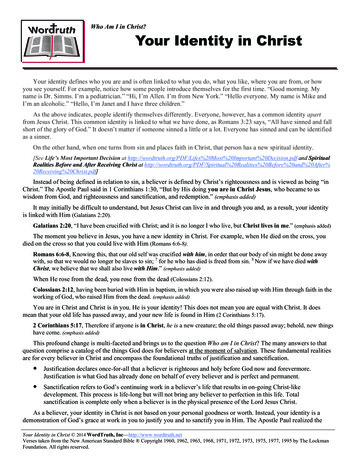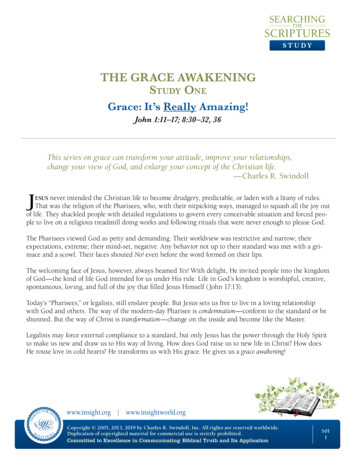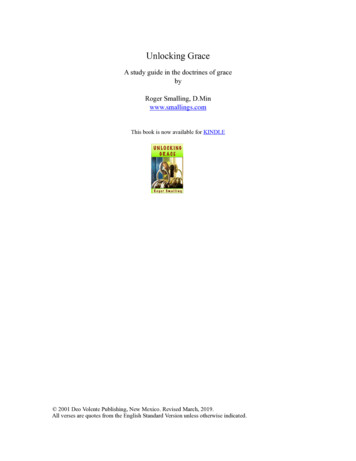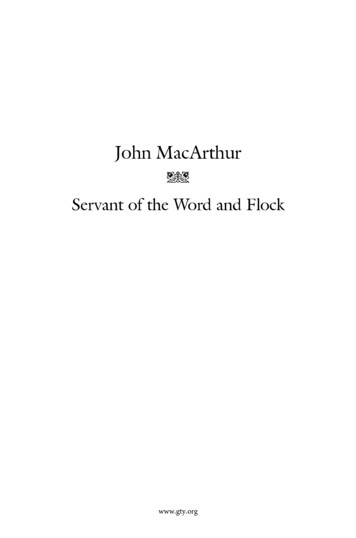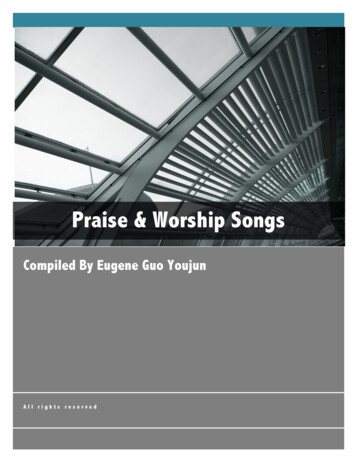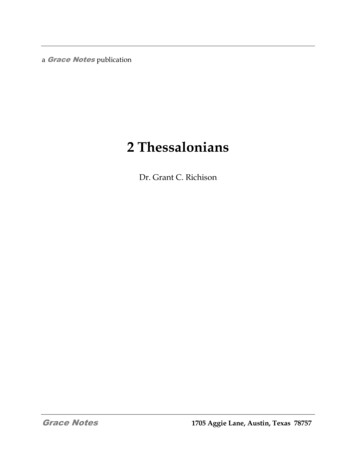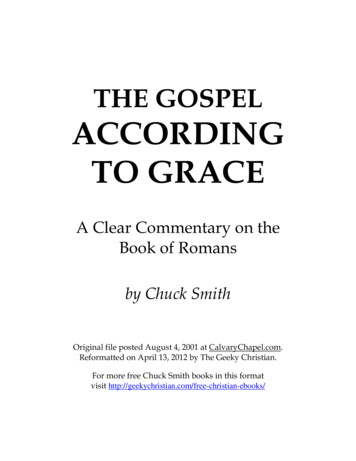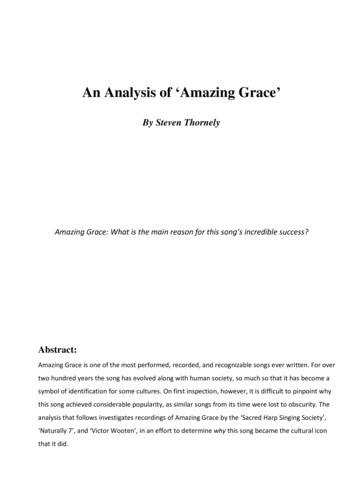
Transcription
An Analysis of ‘Amazing Grace’By Steven ThornelyAmazing Grace: What is the main reason for this song’s incredible success?Abstract:Amazing Grace is one of the most performed, recorded, and recognizable songs ever written. For overtwo hundred years the song has evolved along with human society, so much so that it has become asymbol of identification for some cultures. On first inspection, however, it is difficult to pinpoint whythis song achieved considerable popularity, as similar songs from its time were lost to obscurity. Theanalysis that follows investigates recordings of Amazing Grace by the ‘Sacred Harp Singing Society’,‘Naturally 7’, and ‘Victor Wooten’, in an effort to determine why this song became the cultural iconthat it did.
ContentsIntroduction: . 3The Background Behind Amazing Grace:. 3Musical Analysis: . 4Psychoacoustic Analysis: . 5Discussion – Why is Amazing Grace Successful? . 7Conclusion: . 8Appendix:. 8Reference List: . 10Page 2 of 12
Introduction:Very few would dispute that ‘Amazing Grace’ is one of the most successful and powerful songsever conceived. The songs immeasurable popularity has seen it evolve through a plethora ofmusical styles and connect with a diversity of human cultures over a period of nearly 24 decades.Yenika-Agbaw describes the song as “a cultural artifact loaded with a history of greed, oppression,and hope” (2006, Web), while vocal ensemble ‘Naturally 7’ put it very simply, saying that AmazingGrace is “the most famous song in the world”. The purpose of this essay is to evaluate why thissong has become so successful through an investigation of the song’s musical, psychoacoustic,and contextual properties. Three recordings of amazing Grace will be analyzed, and theextrapolated information will be used to pragmatically compare the recordings against eachother.The investigation technique used here partly consists of what Dunbar-Hall describes as ‘analyticalsemiotics’, the purpose of which is, “to arrive at a statement of the meaning of a piece of music asmusic [ ] through structuralist processes of segmentation of material, tabulation, andinterpretation of data” (1991, p. 128). While this is a valid means for methodologically examiningthis song, it inherently ignores the cultural significance and audience reception of the work.Dunbar-Hall titles this “esthetic level” analysis - a process which is ignored in analytical semioticsbecause it is seen to be a non-neutral criterion in which to judge the work. I have chosen to adopta combination of analytical semiotics and esthetic level inquiry here, as both of these techniquesare pertinent to determining the success of a musically and culturally important song such asAmazing Grace.The Background Behind Amazing Grace:As one might expect, Amazing Grace has a colorful history that holds with it information that couldidentify why the song became successful. Amazing Grace was first a poem written by former slavetrader ‘John Newton’ in 1772 (Turner, 2002, p. 212). The words of the poem tell the story of Newtonbeing confronted by a severe storm during a slave trading expedition in 1748, where he prayed for theLord’s mercy and survived (Rogers, 2006, Web). This event changed Newton’s perspectives on life andPage 3 of 12
religion, as indicated by the phrase, “Was blind, but now am free.” While the story of Newton’s drasticcareer change may seem like a ‘unique’ feature of the song - and perhaps a reason for its success Basker notes that, “There [were] at least six white poets who [were] themselves former slavetraders”(2003, p. 29) from the same era as John Newton, none of whom published poems as successful asAmazing Grace.It was not until 1835 that Newton’s poem was coupled with the melody that is associated with thesong today. The imposed melody was an existing tune to the traditional song, ‘New Britain’ (which wasreportedly based on folk songs, ‘Gallahar’ and ‘St, Mary’ (Turner, 2006, p. 119)) and was introduced byAmerican composer and arranger ‘William Walker’. Prior to this, there were over twenty musicalsettings of the poem, but none of these rivaled the popularity gained by the ‘New Britain’ melody thataccompanies the modern version of the song (See appendix figure 1). This concept of Amazing Graceas an ‘evolving entity’ exists for many aspects of this song, making concrete musical observationsdifficult to discern.Musical Analysis:The closer one inspects the melodic and chordal elements within Amazing Grace, the more apparent itbecomes that terms such as ‘simple’, and ‘generic’ describe the musical elements of the song quiteaptly. As is common in a majority of church hymns, the song is (traditionally) in a major key. The ‘NewBritain’ melody is often put to I, IV, and V chords (See appendix figure 2) in one of the most familiarprogressions of Western music (commonplace in blues, church music, and many forms popular music).That said, the melody lends itself well to a number of reharmonizations that can be chosen accordingto the mood that the artist wishes to portray. Many artists have re-written the melody somewhat overtime granting them many possibilities to alter the chordal structure of the song as they wish. Thischordal simplicity as well as inconsistency seen here may suggest that the progressions of the song arenot the fundamental reason for the song’s success.Similarly to the chordal components of the song, it is very difficult to determine any characteristics inthe melody that justify the immense popularity of Amazing Grace. The melody is concentrated aroundscale degrees that reflect the major triad, with 2nd and 6th degrees used sparingly as passing notes.Page 4 of 12
The song consists entirely of intervals less than a perfect 4th in size, making the song well suited to thehuman voice. The repeated minor thirds at the height of the melody accompany the gloomy lyrics ‘Ionce was lost’ quite appropriately, suggesting that the contours of the melody could be described as‘effective’ - although by no means are they ‘groundbreaking’. Rhythmically, Amazing Grace is also verybasic, being made up of only quavers, crotchets and minims. Its ¾ time signature was commonplace incompositions from its era, providing little evidence as to why this song became a Westernphenomenon while similar hymns remained in the confines of the church. Finally, there appears to beno obvious connection with any of the above elements to the Golden Ratio, again leaving us with noconclusive analytical evidence regarding Amazing Grace’s success.The observations made above are succinctly demonstrated in the three recordings of Amazing Gracethat I have chosen to analyze. Rather than identifying how these examples ‘fit the mould’ of the songthough, it is intriguing to examine how these recordings differ from each other musically, and why thismight be the case. For instance, it can be heard that the rhythm as described by the score (appendixfigure 1) is strictly adhered to in the Sacred Harp Society version, while the Naturally 7 recording has afreer – at times indistinguishable – time feel. Further, the melody in the Sacred Harp Society examplerepeats itself as per the score, while the Naturally 7 example (like many modern appropriations of thesong) holds the final note of each phrase (bars 7 and 14) for an extra three beats, thereby lengtheningthe song from 14 to 16 bars. Instances of the re-composing of this song are likely to be evidence thatmusical elements are probably not the essence of Amazing Grace, and are not the main reason for thesongs success.Psychoacoustic Analysis:In this section, I will be discussing psychoacoustic observations that can be made in recordings ofAmazing Grace, and how these can be analyzed to answer the question of Amazing Grace’s success. Sofar, it has been determined that none of the musical components of the song are particularlyinnovative, and the song has been re-written in so many ways that a penultimate version of the song isquite elusive. While the musical analysis of the song was of little assistance in this case, psychoacousticPage 5 of 12
investigation with the inclusion of esthetic analysis provides a far more appropriate means ofdetermining the success of this particular song.Although the lyrics of Amazing Grace are quite personal, the themes of community andcongregation are portrayed in the psychoacoustic properties of all the recordings underinvestigation here. In the Sacred Harp Singing Society recording, casual conversation can be heardas the song is announced and the group prepares to sing. The signified of this is a sense ofequality between the announcer and choir, a remark that is validated by Turner’s statement, “Intrue democratic spirit, the participants would sit around a hollowed square or circle so that noindividual or group was more important than any other” (2002, p. 117). The shape note singingheard in the first verse as well as the A Cappella setting also signifies the ‘community’ themepresent in this recording. In this case the people are the instruments, and this is likely to be acontributing factor to the songs success.The ‘people as instruments’ concept is also illustrated in the Naturally 7 example of AmazingGrace, where the sounds of a church organ, as well as brass instruments are mimicked in the ACappella arrangement. The ‘congregation’ and ‘community’ themes are psychoacousticallypresented here in quite interesting forms. Signifiers including a solo voice in front of a choir, anembellished ‘improvised’ style melody, and a powerful key change are genre synecdoches forgospel and soul music. These genres present connotations of tight-knit African Americancommunities who are empowered through playing music in groups. People are the importantelement that carries the success of these genres and therefore this recording of Amazing Grace.The same theme can be identified in the Victor Wooten example of Amazing Grace, albeit in afairly obscure way. The Wooten recording has no vocals, and no traditional ‘group of performers’,but it can be heard that the audience is very involved in the song by either clapping or vocalisingtheir enjoyment of the performance. In a sense, Wooten is using Amazing Grace as a vessel topurvey his virtuosic talents to the audience, which increases the songs popularity and expands the‘community’ of people who are connected to the song in some way. Since the invention ofrecording technology, a number of other ‘big name’ artists (including Elvis Presley) have coveredPage 6 of 12
this song, which has helped the song outgrow the boundaries of the church (the ‘congregation’community) and expand into the ‘commercial’ community.Discussion – Why is Amazing Grace Successful?Common elements can be identified between the Sacred Harp Singing Society, Naturally 7, andVictor Wooten recordings of Amazing Grace when viewing these paradigmatically. In the SacredHarp Singing Society example, the song promotes close ties with religion, and the ideals offreedom and opportunity connect closely with morals of the democratic society. The Naturally 7example connotes themes of racial equality, and empowerment of people through partaking inmusic as a group. Finally, the Victor Wooten recording illustrates how the song has been adoptedas a means of expressing musicianship to the mainstream audience. While themes of racialequality, religion, and musical expression prevail through these examples, each of these elementscan be related back to the concept of ‘people as instruments’, and it is my belief that the successof the song can be attributed to this notion.To elaborate, what makes this song unique is the way that the song has connected with a widecross-section of humans over many time periods, and more importantly, the fact that people havebeen the main means of the songs evolution, reinvention, and promotion through time. Thedistinction between the performer and the audience has been blurred in the case of this song, asthe creation of the song has often been a matter of community engagement. Further, theadvertising and distribution of the song has been virtually ‘invisible’ throughout the songs history.This is because the artists and communities who partake in the creation of the song have becomethe promoters and the methods of the songs dissemination. This has created an environment forAmazing Grace to spread on a far greater scale than conventional advertising could allow, and islikely to continue in contributing to the popularity of Amazing Grace for some time.Page 7 of 12
Conclusion:Based on the above analysis, it is my opinion that the main reason Amazing Grace is successful isbecause its existence has been integrated with community engagement. It appears that musicalelements within the song have little to do with the songs success, apart from any connectionsthey hold with the theme of ‘community’. I believe that rather than forming a basis for the songssuccess, the musical constituents of the song have acted mainly as a ‘medium’ in which humanexpression and community engagement have been able to occur through time. While theproposed solutions to this analysis may appear to be side-effects to the success of the song atfirst, I believe that the connection between community and Amazing Grace has existed since thesongs inception in the church, and hence, these elements were pioneering in the songs success.Page 8 of 12
Appendix:Figure 1.Source:(No author). Amazing Grace. Retrieved 25th October, 2011, ce-free-sheet-music.html.Page 9 of 12
Figure 2.Popular Chord Combinations:(Each chord represents one bar of the 16 bar version of the melody)I I IV IIIVVI I IV IIVIIor I I vi IIIIII I IV II vi I Ior I I IVM7 IIIVVI I vi Ivi V I IEtc.Page 10 of 12
Reference List:Basker, J, G. (2003). Amazing Grace: Literature as a window on colonial slavery. Retrieved 15thOctober, 2011 from JSTOR h.edu.au/stable/25163597.Dunbar-Hall, P. (1991). “Semiotics as a method for the study of popular music”. Retrieved 21stOctober, 2011 from JSTOR database, http://www.jstor.org/stable/836920.Naturally 7. (2009). Live performance at Grand Central, Toowoomba. 11th April, 2009.Rogers, A. (1996). Amazing Grace: The story of John Newton. Retrieved 15th October, 2011 fromhttp://www.anointedlinks.com/amazing grace.html.Turner, S. (2002). Amazing Grace: The story of America’s most beloved song. HarperCollins: Ebook.Yenika-Agbaw, V. (2006). Capitalism and the culture of hate in Granfield's "Amazing Grace: Thestory of the hymn". Retrieved 15th October, 2011 from JSTOR h.edu.au/stable/40035014.Audio and video:MySpace (Web). (2011). Amazing Grace. Retrieved 21st October, 2011, amazing-grace-57618729.The Library of Congress (Web). (2007). Amazing Grace/Sacred Harp Singing Society [soundrecording]. Retrieved 15th October, 2011 has.200049059/default.html.Page 11 of 12
YouTube (Web). (2006). Victor Wooten Amazing Grace. Retrieved 15th October, 2011 fromhttp://www.youtube.com/watch?v pEyEu-hS0fA.Page 12 of 12
Amazing Grace is one of the most performed, recorded, and recognizable songs ever written. For over two hundred years the song has evolved along with human society, so much so that it has
